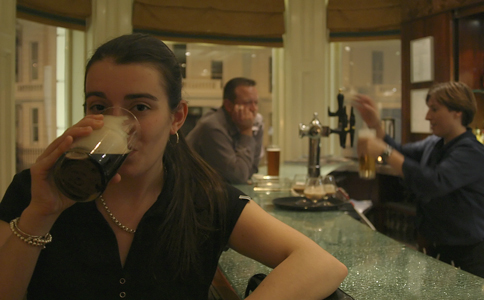|
Dry stouts are among the most interesting beers in the world. They are also not very well understood. The number of myths surrounding these natively Irish beers is greater than any other style. Even bourgeoning young beer geeks often confuse legend with reality.

The author's wife and a pint of Guinness in London
The first truth that needs to be acknowledged is that Ireland is not a terribly exciting beer country. If one is generous, two beer styles can be attributed to the Emerald Isle. One is “red ale,” a rather innocuous, sweetish brew with an amber hue. The second, which is both more definitely Irish and much more important, is dry stout.
Even within the one definitive Irish style, there are only three brewers of global reputation. In order of historical appearance they are Guinness, Beamish and Murphy’s. They are all very similar, yet different enough to justify the loyalty their fans bestow upon them.
Ireland’s lack of stylistic diversity does not diminish the importance of its black, bitter-tart beers that are so well enjoyed around the world. Dry stouts are truly remarkable; they are flavorful, yet low in alcohol. I can think of only one other low-alcohol beer style that asserts itself so boldly (Germany’s Berliner Weisse).
That leads to the debunking of the myth of dry Irish stouts’ strength: these are weak beers. Even Guinness. Even in Ireland. If somebody you know brags loudly about how inebriated they became drinking just a few pints of draft Irish stout on a Dublin visit, you can deflate them a tad by mentioning how they were really proving the placebo effect. Draft Irish stouts are 3.8-4.2% alcohol by volume. For reference, Budweiser is about 5% ABV.
Since a beer’s body is perceived in the mouth, just like its flavor, it is time to debunk myth number three: Irish stouts are actually light-bodied. The artificially-induced, dense, long-lasting head may fool those who taste with their eyes, but a careful (or blind) tasting will reveal that Irish stouts are rather thin.
The reason for this is simple: beer gets both its body and its alcohol from the malt used to make it. Low alcohol beers are made using less malt. There are a couple of things a brewer can do to increase the mouthfeel of a low alcohol beer, but at best the body will be on the lighter side of medium.
None of the above debunking is meant to disparage dry stouts; on the contrary, it is the fact that they are light-bodied and low in alcohol that makes them a great style! They are meant to be session beers, easy to handle and not too filling. One can partake all evening and still be productive in the morning, yet they are full flavored, so taste buds need not suffer for brain’s temperance.
While the evolution of stout is somewhat obscured by the fogs of time, we do know that Arthur Guinness was a key figure in stout history. Not because Guinness is the best stout in Ireland, but it was the first of consequence. He leased the brewery at Saint James’s Gate in Dublin in 1759. In a deal that may seem strange to modern business minds, he leased the space for 9000 years, with the initial payment being about $70 per year. While the rent has gone up since, it would be difficult to argue that it was not a brilliant way to start up a brewing empire with limited capital.
He began brewing porters, a style of beer so closely related to stout that the distinctions may be illusory. The name seems to have evolved somewhat gradually: in 1802 there are records of West Indies Porter being produced at St. James’s Gate, and by 1821 a beer called Guinness Extra Stout Porter was being brewed.
These two Guinness products were stronger than the Draft Guinness we drink today. They were a style we now call Foreign Stout, and are similar to modern bottled Guinness Extra Stout. Like the original India Pale Ales (see Yankee Brew News, February 2004), they were brewed as strong beers to withstand the rigors of export. The beer we know as Draft Guinness was not introduced until 1959. Oddly enough, it was first marketed in Great Britain, then two years later in Ireland, and in 1967 it was finally released in the United States.
In 1883, the Saint James’s Gate Brewery was the largest in the world. While Guinness is still one of the most widely exported beers in the world, the company is no longer independent. It is part of the Diageo Group, which also markets brands such as Jose Cuervo Tequila, Craggenmore Scotch, and Bailey’s Irish Cream.
All dry stouts are made from a relatively simple list of ingredients: water, pale barley malt, roasted barley (or roasted barley malt), hops and yeast. Interestingly, the German Guinness website lists wheat as an ingredient. Whether this is malted or not is unclear. Other than this website, I have never heard of Guinness containing any wheat! I wonder if it is a translation error or a fact that is revealed to the Germans because they care so much about what goes into their beer.
The characteristics of the three Irish dry stouts are similar, and are produced in large part by the roasted barley (or malt) used to brew them: they are dark brown with garnet highlights, have artificially-induced, dense heads, are mildly roasty and somewhat tart in aroma, and light-bodied, with a mild roast flavor and bitter finish. To my palate, Guinness is the most tart and most bitter, and also the least roasty. Murphy’s is somewhat sweeter in the finish, with some interesting, mild cocoa notes in the nose, and Beamish falls somewhere in between.

The author researches a pint of Beamish while writing this piece
The astute reader and rabid Irish stout fan may be upset by my rather derogatory terminology when describing the heads of Irish stouts in the last paragraph. The fact is, they are produced artificially, using nitrogen and restricted faucets. While a fascinating technology, brewing purists eschew nitro-beer for two reasons:
The first is somewhat arbitrary: it just isn’t natural. The second has more solid reasoning: the aroma of a beer that is poured so violently is largely dissipated at the tap, and the consumer misses the subtle notes that so many beer geeks revel in. The lack of carbon dioxide bubbles in the beer also softens its flavor in a way that some feel is detrimental. There is no doubt that the nitro pour has great visual appeal, and therefore will be around for a long time.
Several breweries outside of Ireland produce dry stouts, and at least one (the Albany Pump Station) is in the northeastern U.S. The one I brew at the Pump Station is more like Murphy’s than Guinness; it has balanced bitterness and rich, mocha character, as well as a bit of a bready note that I believe comes from unmalted barley I use as a body-enhancing adjunct.
Staropramen, the famous Pilsner brewery in the Czech Republic, also make a dry stout. It is called Kelt, and is not yet available in the United States (thanks to my friend Mark for bringing this one to me!). It tastes remarkably similar to my dry stout, but it is a tad strong for the style at 4.8% ABV.
Many homebrewers also try their hand at the style, often overdoing the roast flavor, but sometimes coming up with a really nice interpretation of the style. One thing that all of these non-Irish dry stouts have in common is a lack of nitrogen. This really makes them taste quite different from the style benchmarks. They are a bit more assertive, but my taste buds never complain when confronted with flavor.
|


